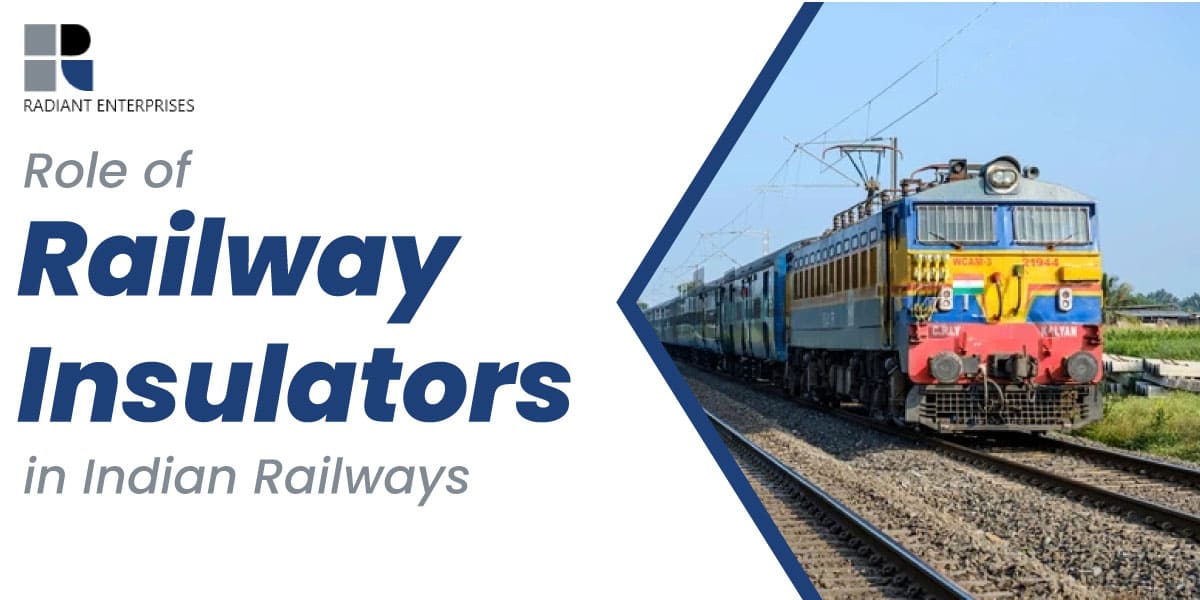
Fill all information details to consult with us to get services from us

Insulators for trains are low in conductivity and possess a very high resistance. Their electrons are tightly locked within their atoms, therefore they don't conduct electricity. Since electrons never move around on their own accord, no current can flow through them. In addition to preventing current loss, insulators increase the efficiency of an electric current by directing its flow in a more concentrated fashion.
Insulators used in railway traction must meet stringent performance, safety, and strength requirements. The primary regulating organisation responsible for ensuring that these insulators are produced in compliance with demand and specification is the RDSO. This insulator type is widely deployed in India's 25kV traction systems for railways, satisfying the country's growing demand for railway electrification. The locomotive industry is the primary user of the roofline insulator.
Types of railway insulators:
RDSO is the primary regulatory application that is used as an electrical traction insulator, and the goal of most of the research and development that goes into these insulators is to ensure that they not only meet but also surpass those standards. Tests are performed on the manufactured insulator on a regular basis, and there is also an acceptance process that must adhere to RDSO regulations. Growing the sample size is primarily motivated by a desire to demonstrate the product's reliability in its claimed uses.
The insulator is put through its paces in addition to the standard
Modern railway insulators manufactured by Radiant Enterprises, one of the most reputed and trustworthy Railway Insulators 25 kV manufacturers in India, may be distinguished from their predecessors thanks to these and other tests, as well as the thorough management of the manufacturing process and the strict adherence to quality control.
Catenary wires strung overhead:
Maximum protection is provided for the connection of electric lines between the locomotive and the train by the one-piece core insulator, which can be used either horizontally or at an angle on the cross arm.
Pantograph post:
We supply a wide variety of insulators for locomotives and railroad infrastructure. We have a design team that could be able to help you out with unique needs.
Supporting rods and terminals for air-disconnect switches:
PPC insulators can be installed vertically, horizontally, or underhung, depending on the specifics of the job site.
Even though many new designs have been added to our already extensive variety of insulators in recent years, our EPDM formula has remained unchanged, and our excellent service record remains our greatest strength.
Our extensive catalogue of insulators features the distinctive cladding developed by WT Henley for use on the module of the high-strength GPR rod. They have been used by a variety of electric companies for years, and their efficacy has been demonstrated in a variety of environments, from arid regions of Africa to frozen wastelands in Canada.
Ingenious, built-in cleaning system:
Polymeric technology, with its open profile design as well as the insulator’s nature of self-cleaning, helps in ensuring vastly superior system performance compared to conventional ceramic technology, which requires constant replacement, washing, and an increased number of pieces to deal with a wide range of environmental challenges.
For aesthetic reasons, our insulators are intentionally unassuming in form. It's an essential safety component for keeping the rail signals unobstructed at all times. Benefits for initial maintenance and construction include less line closure due to vandalism or damage because of the items' vandal-resistant, lightweight, as well as self-cleaning features.
Insulator for railways, 25 kV, class ML-1:
These 25 kV epoxy insulator for railways are built to withstand the heaviest loads in the railway industry, and they are typically used to replace porcelain portal insulators on either side of a gantry. They can be utilised for tunnel applications, where large supporting tubes require characteristics of little deflection, and even for independent registration when strong mechanical stresses are also being stated.
Insulator for railways with a voltage of 25 kV, MK 3:
These 25 kV epoxy insulator for railways, made with Henley's EPDM dielectric cladding materials, are moulded into GRP rods with great strength and resilience. This cladding has long since established itself as the gold standard for success in harsh climates like the arctic or desert. The materials' non-flammability, resistance to pollutants and weather, and other superior qualities make them ideal for underground stations and tunnels, where natural rain cleaning is impossible.
Insulating discs that can be tensioned in pairs or threes:
Horizontal and in-line configurations are the only ones for which this insulator is intended, and it is a direct replacement for three PIN insulators as well as ceramic CAPs, types 121/003/002 and 121/833/001.
Electrical Insulators for the Return Conductor:
It's a modern take on the classic insulator that's been made to withstand vandalism.
Quick-Transit and Light-Railway Insulator:
Light rail infrastructure planners throughout the world are becoming increasingly cognizant of the aesthetic consequences of urban environments’ catenary wires.